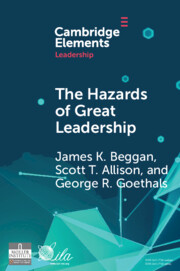Element contents
The Hazards of Great Leadership
Published online by Cambridge University Press: 07 April 2023
Summary
- Type
- Element
- Information
- Series: Elements in LeadershipOnline ISBN: 9781009398589Publisher: Cambridge University PressPrint publication: 11 May 2023
References
- 12
- Cited by

